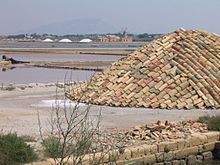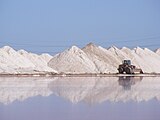Saltworks


A saline is a plant for the extraction of table or table salt . Here, Siedesalinen where, evaporated salt by evaporating a mostly underground manufactured or derived from a natural source brine is extracted from the salt pans where, sea salt by evaporation is extracted from seawater, distinguished.
term
Remarkably, the German-speaking area is the only one that uses the saline term for the two completely different types of salt production. In other linguistic areas, the term is used exclusively for salt production through the evaporation of sea water. The boiling of the brine as a post-processing process has no independent meaning there.
Not to be referred to as a saline
- Desalination plants for seawater, in which the salt is a by-product,
- Salt mines in which the salt is mechanically extracted using the mining process.
A distinction should be made between salines and graduation towers , in which the salt content of the brine was increased through evaporation in order to save valuable fuel. The saltworks and graduation house together are called salt works in technical terms .
Siedesalinen
Siedesaline n make up the largest share of salt production in industrialized countries. The end product, the so-called brewing salt or evaporated salt , is obtained by sustained boiling and thus evaporation of a salt solution ( brine ). The after precipitation remaining of the salt brine is a residual lye or residual brine , dated as Bitter Sole called (which, among other things still dissolved magnesium sulfate is still generally Epsom salts called) and is including as a coagulant in the production of tofu (see nigari ).
To produce the brine in many salt pans, hot fresh water is pumped under high pressure into underground rock salt deposits. There the salt dissolves in the water and the brine obtained in this way is pumped back up and then evaporated. In the past, brines from salty springs were also used, which were naturally enriched with salt underground. Since such sources are rare, they only play an insignificant role for today's industrial production. Sometimes (of course, pre-concentrated) seawater was boiled in salt pans, e.g. B. on the small Danish island Læsø .
The buildings used as salt pans are also known as brewhouses or boiling houses . In Austria , the term Pfannhaus was used until the end of the 19th century after the vessels used for evaporation, the salt pans . In large companies today, closed systems are used that have a higher degree of efficiency .
Today, an estimated 70 percent of world consumption is obtained from rock salt, although more precise information is difficult because many producing countries do not provide any information about the origin of their salt. The production facilities are often in the hands of large multinational companies such as Cargill or Compass Minerals International . There are currently five salt pans in operation in Germany. Together with the salt mines, the total production volume in 2003 was around 14.1 million tons of salt.
Boiling pan of the Luisenhall salt works
Former salt works in Bad Zurzach (Switzerland)
Salt boiling in a reconstructed medieval salt works, Schwäbisch Hall
Sculpture of a salt boiler around 800 BC At the Salzhof in Bad Salzuflen
Share of the Heilbronn salt works on January 28, 1922
Sea salt pans (salt marshes)
When extracting sea salt , the salt water is first pumped into several evaporation ponds connected in series for pre-concentration. In each stage the degree of saturation of the brine increases and most of the gypsum is precipitated. The saturated brine is then pumped into crystallization ponds, in which the final evaporation takes place.
For a long time, the economic organization of the salt pans corresponded to that of agricultural businesses. Many French small businesses rarely cover more than 2 hectares and thus only offer a sideline for the salt farmers who work there. Larger, internationally operating companies such as the Compagnie des Salins du Midi et des Salines de l'Est in southern France and comparable companies in the USA are increasingly emerging .
distribution
Naturally, saltwater salines can only be created in coastal regions. Several prerequisites are necessary for successful operation.
- an at least normal (oceanic) salinity of the coastal waters for a good yield, i.e. not on the Baltic Sea , as this is a brackish sea.
- Flat banks to create large salt marshes.
- Intensive and regular sun exposure for sufficient heat supply and evaporation.
- Sufficient wind to exchange the humid air with "absorbent" dry air.
- Little rain, only a single heavy rain shower can solve the "harvest" of weeks.
In Europe , salt pans can be found in Brittany on the French Atlantic coast, on the Black Sea and on the Mediterranean , here at Salin-de-Giraud , the Ston saltworks or the Sečovlje saltworks . They are also found on the Canary Islands , on the Chinese Sea , on the Indian Ocean and in places in Central and South America . Few can be found even further north, for example in the Bay of San Francisco .
A special feature in Germany was a saltworks near the Stade nuclear power plant in Lower Saxony, which was operated with its district heating. When the power plant was shut down in 2003, the saltworks were shut down.
In eastern Tibet and the northern Yunnan Mountains, the existing salt springs in saline basins are used for salt production.
Evaporation basin of a salt works on the Île de Ré
Aerial view of the salt ponds in San Francisco Bay
Sea salt loading at the salt basin in Walvis Bay
Salt pan on Dry Creek, Adelaide
Follow-up uses
Many historical salt pans have been abandoned for economic reasons after the brining out, and will fall into disrepair if there is no further use. In Halle (Saale) you can find the saltworks of Halle's saltworkers, which were built between 1719 and 1721 and are regularly restored. The Halloren- und Salinemuseum Halle is located in the buildings , in which the historical salt production is regularly demonstrated in the form of a show boiling. In the north Hessian spa town of Bad Sooden-Allendorf , the history of the former saltworks with former production facilities and a salt museum can be easily traced, for example there is an elaborately restored graduation tower, which was partly integrated into a thermal bathing landscape . A positive example of successful use of the existing building is under ensemble protection standing Old Salt Works in Bad Reichenhall. A local developer has acquired the Brunnhaus, including the connected brewhouses, stores and workshops. The so-called source building itself still exists unchanged with the technology from the early 19th century and can be visited during guided tours. The remaining buildings have been extensively renovated and now house a medical center, a pharmacy, retail business, gastronomy, the Reichenhall Academy and the magazine 4 , which is used for cultural events.
See also
- List of salt pans in Germany
- Saline contract between Bavaria and Austria
- Halurgy (salt works)
- Salt fields of Trapani and Paceco nature reserve
- Salt scoop
literature
- Hans-Heinz Emons , Hans-Henning Walter: Old salt pans in Central Europe, on the history of salt production from the Middle Ages to the present. VEB German publishing house for basic industry, Leipzig 1988.
- Christian Leeck: The introduction of technological innovations in the saltworks of the 16th century . GRIN Verlag, Munich 2007, ISBN 978-3-638-66282-6 .
- W. Leidinger: Early salt production in Werl, Soest district, Westphalia. In: Archäologisches Korrespondenzblatt (Mainz) 13, 1983, pp. 269–274.
- Theo Simon: Salt and salt production in northern Baden-Württemberg. Geology - technology - history. Thorbecke, Sigmaringen 1995, ISBN 978-3-7995-7642-0 .
- Günter Pinzke: On the history of the mining and saltworks in Mecklenburg-Western Pomerania and their initiators . In: Scientific journal of the Wilhelm Pieck University Rostock. Social Series 2, 1986.
Web links
- Publications on salt pans and salt in the Opac der Regesta Imperii
- Salt production in the Swiss salt works on the Rhine - scheme with texts, photos and short films
- “Luisenhall” - The last European pan boiler with its own salt works in Göttingen
- “Sea salt from Guérande” - traditionally managed sea salt pans in Brittany
- “The taste of the sea. Salzbauern in der Bretagne ” , Deutschlandfunk , September 1, 2007, radio feature
- Westphalia regional: Salt production in Westphalia
Individual evidence
- ^ Jacob Andreas We (e) ber: Easy chemistry for craftsmen and their apprentices. Wilhelm Heinrich Schramm, Tübingen 1791, p. 47 (GoogleBooks)
- ↑ Seo Yong-ha: The Salt Springs of Yan Jing . Documentary 2007. Broadcast on ARTE, Unterwegs auf dem Dach der Welt (4/6), Wednesday, September 8, 2010, 9:15 am.
- ↑ Technical Halloren and Saline Museum Halle ( Memento from November 1, 2007 in the Internet Archive )











